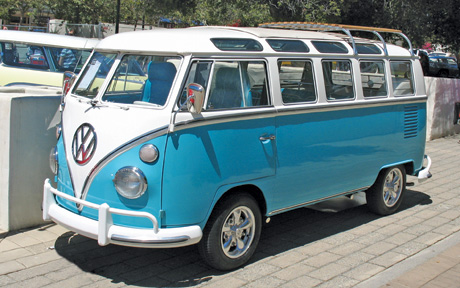
During the 1950s, the people charged with the task of selling imported cars were often more in tune with what the market wanted than the manufacturers.
Witness the string of successes that U.S.-based BMW and Porsche importer Max Hoffman had with the Porsche Speedster, BMW 2002 and Bavaria.
In the case of the VW Microbus, it was Dutch importer Ben Pon who conceived of a light van based on VW Type 1 (Beetle) mechanicals. Save for rare oddballs like Buckminster Fuller's Dymaxion car and the Stout Scarab, nothing like the VW Microbus had ever been seen.
Originally, VW tried to build the Microbus on a standard Beetle pan. But this wasn't robust enough, so a bespoke pan was designed for the Microbus. Amazingly, however, the wheelbase remained the same as that of the Beetle, as did the 1100cc 24hp flat four from the Beetle of the day.
Surprisingly, given its bread loaf-like shape, the Microbus' drag coefficient was lower than the Beetle's. From the Microbus's debut in March of 1950, it was a solid hit. It was used all over Europe as everything from a delivery van to an ambulance. It had little competition other than the slightly more conventional-looking Citröen H Van, which had been introduced in 1947.
Hip transportation
But it was on American college campuses and in places like Haight- Ashbury and the East Village that the Microbus made the greatest impact.
Adopted as the official vehicle of the counterculture, few escaped loads of macrobiotic produce from the local commune-or the haze of bong smoke from loaded passengers.
Aerial shots of the line of cars heading to Max Yasgar's farm during the Woodstock Festival seem to reveal that every third vehicle was a Microbus. And while this was years before the notion of a practical zero-emission vehicle, nothing about the performance of the Microbus would lead one to believe that it wasn't solar powered. This seemed to be enough to satisfy the hippie ethic.
All T1 Microbuses produced through 1967 carried anachronistic split screen windshields, and they were powered with 1,100, 1,200 or 1,500 cc engines. None produced anything approaching adequate horsepower for sustained travel on Interstate highways. Models from 1950 to early 1955 were nicknamed "Barn doors" because of the tall engine compartment lid.
Some parts, such as the gas tank, front lever shocks and steering that are unique to these early buses and they are now rather difficult to find.
Windows galore
The most basic model was the Kombi, which was a commercial and passenger van with removable rear seats. Most were 11-window models, as they had two front door windows, six side windows, two windshield panes, and a rear window. Kombis had no headliners or carpeting, and the rear seats were optional. Standards added carpeting, a headliner and middle and rear seating.
Deluxe models featured two-tone paint and nicer interiors. Deluxe drivers also got additional side windows and corner windows, which made the 13-Window or 15-window bus.
Sambas featured a series of little sky lights, which made them 21- or 23- window models. Sambas also sported a sliding fabric sunroof and polished aluminum trim. These features make them the most collectible Microbuses.
Other models included panel vans without side windows, pickups and campers. The official converter for the latter was Westfalia.
For those dead-set on reliving the carefree days of bad acid, violent campus protests, rock festivals with one portable toilet for every 25,000 people and the prospect of being drafted into an enormously unpopular war, there are plenty of Microbus survivors out there.
The same rules for selection apply to any other Beetle variant. Rust in the floor, the battery box and under the windshield is bad news. Mechanical issues are not. Mechanical parts have been produced in Latin America for years and are quite inexpensive. Obviously, the Deluxe models are the most expensive to restore, as they have more elaborate interiors and bright work. Cloth sunroof replacement can also be somewhat expensive.
Demand remains high
Other than the reactions Microbuses elicit from the driving public, there's nothing particularly fun about the driving experience.
Microbuses are horrifically underpowered, have mediocre drum brakes and a bus-like steering wheel position. But like a nice BMW Isetta, great ones always seem to bring active bidding at auctions and when they appear on eBay.
With baby boomers still around and romanticizing about the Microbus and its place in the 1960s, it seems like it will be quite some time before interest and demand tails off.
